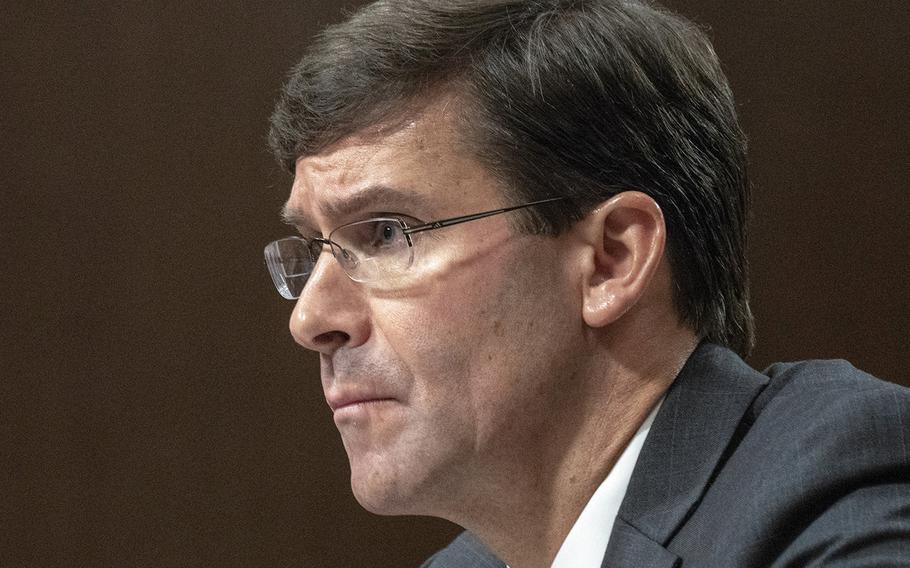
Defense Secretary Mark Esper vowed to continue dialogue with Turkey and the Syrian Democratic Forces to ensure the accord reached Thursday remains in place for the agreed to five days. (Stars and Stripes)
WASHINGTON – American troops will not physically monitor the temporary ceasefire in northeastern Syria between NATO ally Turkey and the Kurdish-dominated militia that the United States has backed in recent years to fight the Islamic State in that country, Defense Secretary Mark Esper said Friday.
Esper also confirmed U.S. servicemembers will leave that region of Syria, though he vowed to continue dialogue with Turkey and the Syrian Democratic Forces to ensure the accord reached Thursday remains in place for the agreed to five days. Kurdish YPG, or People’s Protection Unit, forces that dominate the SDF have 120 hours to evacuate a negotiated safe zone, which extends about 20 miles south into Syria from Turkey’s border. Vice President Mike Pence said Thursday that Turkey agreed to make the pause of its military invasion into northeast Syria permanent if Kurdish fighters successfully moved south out of the region during the five-day ceasefire.
Esper said he spoke with Turkey Defense Minister Hulusi Akar by phone Friday morning amid reports of continued fighting between the two sides. Esper said he reiterated the American demands that Turkey ensure ISIS fighters imprisoned in makeshift compounds within the northeast region were unable to escape and people in that area, including Kurds and other minorities, were ensured safety.
“This ceasefire is a much-needed step in protecting those vulnerable populations,” he told reporters at the Pentagon.
Esper also said he would continue talks with Akar next week when he travels to Brussels for a NATO defense ministerial after visiting several countries in the Middle East, his first trip to the region since becoming defense secretary in July.
While the U.S. military will not maintain a permanent presence in northern Syria, President Donald Trump ordered this week that the military withdraw entirely from the country aside from a small number of special operators at the Tanf garrison near the borders of Jordan and Iraq. In addition, American drones will continue to conduct intelligence, surveillance and reconnaissance operations in the area, a senior defense official said on the condition of anonymity. Those drones would focus for now on ISIS, including on the prison camps where thousands of the terrorist group’s fighters are being held. It remained unclear Friday whether the United States would conduct other air operations in northern Syria related to the ceasefire.
However, some ISIS fighters have already escaped the camps that until this month have been run by the SDF, U.S. officials said Friday, declining to elaborate on how many might have been freed amid the fighting. Most of the roughly 20 camps that hold an estimated 11,000 ISIS fighters are farther south in Syria, and the SDF has maintained control of prisoners in them, these officials said.
U.S. troops began withdrawing from northern Syria on Oct. 6 after Trump ordered the 50 to 100 special operators stationed along the Turkish border out of the area once Turkish President Recep Tayyip Erdoğan informed him that Turkish forces would invade Syria.
While the United States has relied heavily on the YPG to fight ISIS, including supplying it heavy weaponry, Turkey has long considered the group a terrorist organization tied closely to the PKK, or Kurdistan Workers Party, which has maintained a decades-long insurgency in Turkey. The PKK is also labeled a terrorist organization by the United States. The Turks said their military operation is designed to drive the YPG away from northeastern Syria, where the Kurdish group had carved out a semi-autonomous homeland after expelling ISIS from the area.
Trump also ordered this week that the vast majority of the roughly 1,000 remaining U.S. servicemembers in Syria leave the country, partially fulfilling a long-held pledge to remove American forces from Middle Eastern conflicts that he believes should be handled by the people who live there.
But his decisions on American involvement in northern Syria have drawn stern backlash, including from Trump loyalists on the Capitol Hill, who have said they worried the move abandoned a successful partnership with the Syrian Kurds and risked the reemergence of ISIS.
Trump has repeatedly defended his position of ending most American operations in Syria. On Friday, he tweeted he spoke again with Erdogan by phone, who insisted he wanted the ceasefire to succeed and played down reports of continuing violence as “minor sniper and mortar fire that was quickly eliminated.”
“There is good will on both sides & a really good chance for success,” Trump tweeted. “The U.S. has secured the Oil & the ISIS Fighters are double secured by Kurds & Turkey.”
dickstein.corey@stripes.com Twitter: @CDicksteinDC